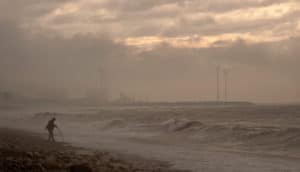- The Meaning of Critical Thinking: A Key Skill for Navigating Today’s Information Landscape - November 3, 2025
- Grandparents Can Develop Activist Grandchildren - September 29, 2025
- Top Six Reasons Credit Union Benefits Are a Smart Choice Over Banks - August 18, 2025
Last Updated on February 27, 2025
In this post, I discuss climate change angst and ways to overcome hopelessness about the future. A climate change angst definition is a sense of fear and hopeless feeling about the future because of climate change. Also known as eco-anxiety, eco-distress, planetary grief, and climate change paralysis, it is not a clinical diagnosis but a natural response to the prospect of irreversible climate change. Climate change angst and feeling hopeless can lead to mental health challenges such as anxiety, depression, and burnout.
Almost all scientists agree on the negative impacts of climate change on health and well-being. Feelings of anxiety and depression are reasonable reactions to a threat. Anxiety can be helpful if it alerts you to danger, but your mind may be telling you about threats such as rising sea levels that you can’t control.
Who is Impacted by Climate Change Angst?

Young people are inheriting a crisis they had little role in creating. Despite warnings from scientists, the world has not united to deal with climate change. Teenage angst comes from industries and governments prioritizing short-term gains over long-term sustainability. A natural reaction for someone living in a country that has not done their part is to feel angry and betrayed by their leaders and hopeless about the future.
Teenage angst about climate change is widespread. Research shows that half of young people report climate change hurts their lives. Almost half believe they are going to be harmed by climate change. People ages 16 to 25 across various countries were polled; 59% were very or extremely worried, and 84% were at least moderately worried.
People with mental health diagnoses are at more risk for climate change anxiety. Also, those that lack a strong social support system may react more intensely.
Vulnerable groups more likely to experience climate anxiety are females, individuals who identify as nonbinary, and those from poorer families.
Navigating Climate Change Angst: Practical Steps for Personal Wellbeing

Climate change isn’t going away, so how do you deal with anxiety caused by real threats and not become debilitated? Or you may be interested in helping someone in your life who is part of the groups vulnerable to climate change angst.
You can build resilience to eco-anxiety with strategies to manage your feelings, care for yourself, and stay hopeful.
Acknowledge Your Feelings
One possible reaction to climate change angst is avoiding it. However, this strategy does not help build resilience.
Validating your emotions is the first step toward addressing them. Eco-anxiety is not irrational; it’s a sign of your awareness of the threat. Rather than putting your head in the sand, share your concerns with friends, family, or support groups. This helps you manage stress and uncomfortable emotions like feeling hopeless.
Another strategy is called cognitive reframing. Reframe negative thoughts into positive ones. For example, rather than consuming dire news and thinking about the end of the world, focus on the progress that is being made and the many good parts of your life. Dealing with uncertainty is difficult, but focusing on positive efforts rather than outcomes can reduce angst.
Practice Self-Care
Create a stress management plan that includes understanding how your body experiences stress and what coping strategies work for you.
Understand How Your Body Reacts to Stress
Stress appears in your body as physical sensations. It may feel like a tension headache or a knot in your stomach. A good investment of time is to monitor your body’s reactions to stress for a week, logging where you feel it and what triggered those sensations.
Use Coping Strategies
When you understand how your body reacts to stress, you can take steps to manage it before it becomes overwhelming. The ways that you manage stress are called coping strategies.
Manage Your Emotions
If you need to manage your emotions, try activities that ground you, such as mindfulness, exercise, or art. Spend time in nature to reduce stress and reinforce your personal connection to the environment.
Manage the Situation
Coping strategies also include managing the situation that is causing you stress. Setting boundaries and finding social support are ways to deal with stressful situations.
Setting boundaries is essential for preventing stress. Be ready to say no to tasks or situations that cause you stress. For example, your family might not be sympathetic to your environmental concerns, perhaps even mocking you for being worried. Draw a firm line with them about these conversations. You’ll probably get along better.
Find support among your family and friends. Young people might reduce their contact with friends if they are dealing with climate change angst. Encourage them to stay involved.
Normalize conversations about climate change. In addition to helping yourself, you also open a space where others can deal with their emotions.
Seek Professional Help When You Need it
Mental health disorders are physical body issues, just like the flu and heart disease. The stigma of mental illness causes too many people not to seek treatment. Don’t fall into the trap of blaming yourself if you are anxious or depressed and need help. You’d go to the doctor to treat your heart; do the same for your brain.
How do you know if you need help? Here is a screening tool that you can use to check the severity of your symptoms.
NOTE: Self-screening is a way to see how severe your feelings are, but the only way to know for sure is to seek help from a professional. If your symptoms worry you, or if people close to you suggest you get help, speak with a therapist to help you decide whether your symptoms are manageable or require support.
Screener for Climate Distress
Rate each item on this scale:
0 = Not at all
1 = Several days
2 = More than half the days
4 = Nearly every day
Over the last 2 weeks, how often have you been bothered by the following problems?
1) Feeling nervous, anxious, or on edge because of global warming
2) Not being able to stop or control worrying about global warming
3) Little interest or pleasure in doing things because of global warming
4) Feeling down, depressed, or hopeless because of global warming
Scoring Instructions
Add your scores on items 1 and 2 together. Totals can range from 0-6, with 3 and higher being considered an indication of generalized anxiety disorder.
Add your scores on items 3 and 4 together. Totals can range from 0-6, with 3 and higher considered an indication of depression.
Most therapists are trained in how to manage stress. However, some therapists specialize in climate-related mental health issues and can provide tailored strategies to manage anxiety and focus on solutions. Resources like climate-aware therapy programs are increasingly available to those in need.
Focus on Hope

However, the second meaning of hope is desire. If you are clear about your vision of a healthy earth, you can take steps to make it happen in a way that taps into your skills. Macy calls this “active hope.” With active hope, you can abandon the need to do everything yourself and focus on contributing to the bigger effort. Active hope strengthens our desire to act. And together, we can make a difference.
“Since we each look out onto a different corner of the planet and bring with us our own particular portfolio of interests, skills, and experiences, we are touched by different concerns and called to respond in different ways.” ~ Joanna Macy
While the reality of climate change can feel paralyzing, cultivating active hope, engaging with supportive communities, and reframing the narrative from individual to collective responsibility can help activists stay healthy. Recognizing that action about contributing meaningfully within your ability is key.
Get inspired by reading about people combating climate change. Share narratives of progress, like renewable energy advancements or community-led conservation efforts, to support motivation and hope.
Added on 1/31/2025: I was fortunate to attend a concert of the Grammy Award -winning group Chanticleer last night – front row! And was I surprised that they sang “Future Ones,” composed by Ayanna Woods and inspired by interviews with Joanna Macy! In the concert book, they include this quote from Joanna Macy:
“There’s a song that wants to sing itself through us. We just got to be available. Maybe the song that is to be sung through us is the most beautiful requiem for an irreplaceable planet or maybe it’s a song of joy of joyous rebirth as we create a new culture that doesn’t destroy its world.” ~ Joanna Macy
Enjoy an excerpt of “Future Ones” posted by Chanticleer on YouTube.
Act and Make a Difference
Active hope is motivating. Hope grounded in actionable steps helps you stay engaged and protects your mental health. Action is an antidote to angst.
People who believe they can make a difference have less anxiety. Make sure your actions contribute to your mental health. Feeling a responsibility to act when you are vulnerable to mental health issues can lead to burnout, anxiety, and depression. But if you have a clear idea of what you want to see happen and feel your actions will make a difference, you can improve your mental health. Even when stressful, acting in alignment with one’s values can provide a sense of purpose, which buffers against despair. Find a sustainable balance.
You don’t have to save the world. Even small victories can provide mental benefits and reinforce your belief in making change.
The 5-Step Activism Path
If you are unsure how to get started in environmental activism, here is a guide:
- Find the Cause Closest to Your Heart. Even if you know the cause closest to your heart, focus. There are so many ways to make a difference for the environment. For example, your goal could be to make an ocean free of plastic, eliminate arsenic residue around old plant sites, or save coral reefs. Don’t get overwhelmed trying to solve every environmental issue.
- Clarify Your Unique Skills. Inventory the skills, knowledge, and motivation you bring to the table. You’ll be more effective if you use the gifts you already possess. And with effectiveness will come more motivation.
- Do Work You Love. Find an activism method that will light your fire. Sarah Corbett of the Craftivist Collective created a campaign that involved crafting canaries and sending them to elected representatives to remind them that climate change is looming. Peter von Tiesenhausen copyrighted an art installation on his land to prevent a pipeline from being installed. Consider what you enjoy and match that to your goals.
- Make a Difference. The time you spend on changing the world is precious, so make it count. Ensure the work you choose makes a real difference to a person, a group, or an organization. If you are busy, perhaps adopt eco-friendly practices like reducing waste, conserving energy, and supporting businesses prioritizing sustainability. Your choices added to others do make a difference.
- See Change Happen. Ready yourself by setting goals that will motivate you and keep you focused on achieving the best results from your work. And celebrate your impact.
Collective Action and Community Support

“Organizing looks different for everyone. My favorite tools for mobilization are words. I share stories of climate solutions through written or oral pieces. Understand what skills or talents you can offer, then search for ways to use them. If you’re an adventurer, invite underrepresented individuals on your outdoor excursions. If you’re concerned about mental health, host safe spaces for people to discuss their climate emotions. The opportunities are endless.” ~ Tania Roa, Eco-Anxious Stories
Empowering the Future
In this post, I discussed climate change angst and ways to overcome being hopeless about the future. Climate change angst is strong evidence of your care for the planet and its future. While the weight of the crisis can make you feel overwhelmed, using a mix of self-care and action helps you transform your fear into hope. Each step you take, no matter how small, contributes to a larger effort to protect and preserve the world.
READ NEXT
Kids Take Legal Action to Protect Their Future
How Hopeful Environmentalists Can Support Environment Protection and Fight Injustice
Little Miss Flint Is Passionate About Environmental Justice
How To Use a Compassion Fatigue Test to Battle Burnout Being deeply involved in addressing challenging issues—particularly those that are emotionally intense—can lead to compassion fatigue.
The Climate Psychology Alliance provides support for those struggling with climate change angst.
Active Hope: How to Face the Mess We’re in without Going Crazy, (2022) by Joanna Macy and Chris Johnstone. The 2012 edition is available free at archive.org.
The Resilience Project is a UK-based organization for young people concerned about the climate crisis. They aim to strengthen resilience, develop leadership skills, and turn the tide on climate change.



